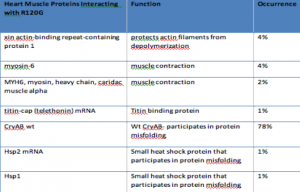Kent Jarvis and Dr. Julianne Grose, Department of Micro and Molecular Biology
Goal Achievement:
The original goal of my project was to find substrates of hR120GCryAB using a yeast two-hybrid model. Over the past few months I was able to achieve this goal. I was able to find over 11 novel substrates that bind with hR120GCryAB. This is new knowledge that had not ever been known before and will hopefully help aid in future treatments of cardiomyopathy.
Project
The first task that we had to deal with was figuring out if a studying a human gene would work in yeast using the Yeast-two hybrid system. We knew that our protein would bind to itself, so we allowed the different constructs that we had developed to be transformed into yeast and using selective media we tested for their growth. (Fig 1)
Once we established that we could continue with our project we proceeded to have the run the screen. We used hR120GCryAB into the bait and then a collection of proteins expressed in the heart. By doing this screen we would be able to establish which proteins would be able to interact with the mutant form of the protein and then compare it to what proteins would interact with they wild-type protein. I will specifically discuss the findings from the mutant form of the protein (Jarvis).
To do the screen we had our hR120GCryAB in solution with all of the heart proteins on separate plasmids. These plasmids were then mixed in solution with yeast. After they were mixed well together and had time to insert into the yeast, we then plated them on selected media. The selected media will only allow yeast colonies to grow that hR120GCryAB and another heart protein (Grose). We then took all of these colonies streaked them on a separate plate and allowed them to grow. Once they had grown we took those colonies and prepared them for sequencing. This was one the major challenges that our project faced. We had a difficult time taking hundreds and hundreds of colonies and the extracting the plasmids from the yeast cells. After several months of work we were able to find three different types of proteins that interacted with hR120GCryAB (Jarvis).
Results
Three types of proteins that interact with hR120GCryAB
The two main types of proteins that interact with the mutant CryAB are
1. Heart muscle proteins
2. Heat shock proteins

hR120GCryAB plays a vital role in heart structure control. Table 1 shows the percent it interacted with
hR120GCryAB. There were a 4 other proteins that had a one percent interaction or less that are not listed
on the table, TNS1-Tensin 1, elF3m, HLA-A, DCAF6.
Conclusion
The research conducted made possible through the orca grant and Dr. Grose’s Lab has made it possible to draw closer to finding answers on the affect hR120GCryAB is having on cardiomyophy in this rare genetic mutation. My hope is that in the near future we will be able to compare the wild-type protein verses the mutant protein and be able to lean more about what is the cause so that treatments may be implemented to help with this specific case of cardiomyopthy but also draw closer to understanding how to defeat cardiomyopathy.
References
- Grose, Julianne. Unpublished results, 2011.
- Jarvis, Kent. Unpublished results, 2011.
